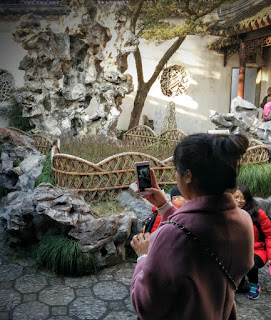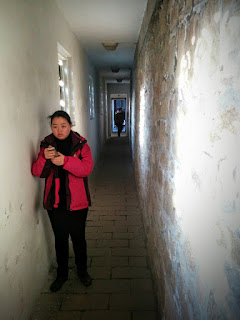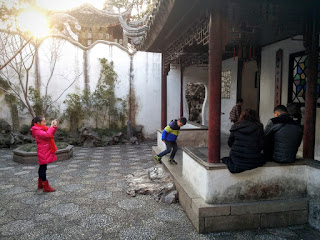It's been more than nine (9!) months since my last post. Before you condemn me for slacking, dear reader, consider that I have been writing on another platform and another subject, but still writing nonetheless. The site is humbly called Start a New Language, and I'm writing about starting to learn new languages and what I'm learning about learning languages from the process.
What else? After surviving the grilled cheese cafe, some catering and chef's table events (overlooking that I'm neither a chef nor do I currently own a table), and a water kefir company that ended before it began, I moved back to Taiwan in August. I moved into a new apartment with a new, multitalented roommate, and aside from languages, have been practicing yoga and learning how to make vegan hum-bow.
In December I went back to Seattle for a month. I got ordained and married my friends in San Francisco, finally visited my idol's fermentation deli in LA, and rang in the new year with a snowball fight at a Honcho Poncho show. The rest of the time I was immobile inside my revitalization chamber.
I got back to Taipei last night at midnight, after a 22-hour itinerary around the arctic circle where it was constantly between 2 and 4pm, with a stop in Tokyo for a bowl of soba. This morning I woke up at dawn. It's cool and rainy, but not nearly as cold as Seattle. I got dressed and went down the little street where all the shops are. Most stores in Taipei are still closed at 7:30, even coffee shops. The exception are breakfast places, which often open as early as 4:30 to accommodate commuters on rough schedules. I went to the noodle thread place for a steaming bowl of rice noodle thread soup topped with garlic, chili, cilantro, and a big ladleful of oysters. Grösartig!
Oyster farming is supposed to be one of the most sustainable forms of protein production, just saying.
I'd given up on writing here all this time since a) I told myself I was too busy, and b) it was starting to become more of a way to avoid deciding what I really should be doing than something I actually felt like doing. I think I've made progress on the latter reason, and the former might be solved if I can take less time writing each post, namely by obsessing less but also by making them shorter. On that note
Thursday, January 12, 2017
Tuesday, April 5, 2016
Back alley reportage
The other day, on my way to getting arugula from the Avocado Lady I took a shortcut through a residential block. It's common for residents to turn their first floor apartments into shops, and one apartment I passed had bins of vegetables out front. I spotted a couple bunches of asparagus, another item on my list.
The owner was napping in a reclined chair in the doorway when I arrived, but when I stopped to look he sat up, smiled, and asked where I was from. I told him.
"Hey, how come you guys like to eat tomatoes, potatoes, and onions so much?" he asked.
"I guess we just grew up eating them," I offered.
I picked up the two bunches of asparagus and asked the price.
"That's nine," he said, meaning nine Renminbi (about $1.40) for 500 grams.
I hesitated, trying to remember the price from the last time I'd bought asparagus.
"Let's weigh it and see," the man said, and placed it on the scale. "That's eleven."
"I'll just take one then," I said. The other bunch was a little wilted.
"They're fine, take them all!" he said. "Look." He took a knife and cut off the ends of the stems, and showed me the new ends. They still looked withered, but I took them all.
Ever the nosy pedestrian, I interrupted this man on his phone to ask him if he knew anything about the tree behind him.
"I planted it," he said. "Fifty years ago."
I wondered if he was a lot older than he looked.
"Wow! Amazing!" I offered, while he looked at me severely. I turned around and kept walking.
I was intrigued by this "Coffee & More" sign above a restaurant near my new apartment. I didn't see any coffee machines inside the restaurant, so I approached a waitress standing outside and asked.
"Excuse me. That 'Coffee' sign up there, what's it referring to?"
"It's a beverage," she replied, lifting an imaginary cup to her mouth.
Across the street from the Avocado Lady, outside of a butcher's shop, there was a sign saying "Noodles, 2F". Hungry, we pushed in, past the men chopping whole ducks into parts. There was another sign scratched onto the back wall of the shop pointing to the left. Up an extraordinarily uneven, narrow staircase, we came into this room. Bowls of noodle toppings were arrayed in the corner. The rest of the room was full of empty tables.
A woman came out of the kitchen and stood in front of us without speaking.
"Still have any?" we asked. She nodded and asked us what toppings we wanted.
Noodles with kaofu (烤麸), a spongy thing made out of fermented wheat gluten. So it's basically a type of bread.
Monday, March 14, 2016
The True Face of Shanghai (with Food Bonus)
Shanghai Exhibition Center, near West Nanjing Road.
City buses in Shanghai are equipped with TVs that show a variety of programs. The most common are vine-like, nonstop reels of cats, dogs, and humans doing stupid things or falling over.
A special reclamation orifice for pernicious garbage at Pudong Airport.
A private rock garden in the former French Concession.
Food Bonus:
Here's what I made last weekend for brunch: Arugula salad, eggs n' dill, warm pears, peas, and passion fruit, sage beets n' kiwi, balsamic strawberries and bananas, and avocado toast.
A congee place in Hong Kong (!), where I'm staying for a couple days while my China recharges.
Tuesday, March 8, 2016
Cafe Opening; or, How it Almost Suddenly Ended
Last Friday I started cooking brunch at a cafe near the former French Concession, and predictably, something caught on fire.
The cafe's kitchen is in the basement, and has about two square meters of floor space. There's a big deck oven, two refrigerators, a cluttered countertop, a sink, flour bins, and a filing cabinet claiming most of the room. In the remaining space we managed to squeeze in a big gas-powered grill, sticking a five kilogram gas canister in one of the cabinets below, rubber hose sticking out and running under the grill to the back.
This big grilling surface was the key component in our operation: our showcase dish was sourdough buckwheat pancakes, and to cook enough pancakes to satisfy the orders that were going to be pouring in as soon as we started, we would need to be able to cook a whole batch all at the same time. The lonely little electric burner the kitchen already had was going to be laughably insufficient.
I had tested the burner the night before. The stove had filled the kitchen and the cafe above with toxic-smelling fumes, part of it had turned from the original shiny silver to a plasticky yellow, and the back of the grill got much hotter than the front. But these problems notwithstanding, I was pleased to see it produced some of the most evenly hued golden-brown pancakes I've been able to make so far.
I got to the cafe early Friday morning, crouched into the basement kitchen, put on my gas mask, opened the gas canister, and started the grill. I mixed the pancake batter while it heated. The stove began letting off noxious fumes again, but not as profusely as the night before.
The barista/cashier came in and stood by the door. He started coughing.
What's up? I asked.
Not much, just curious, he said.
Just making some pancakes, I replied.
Oh. Cool, he said. He went back upstairs.
I had just turned back to my batter measurements when there was a sound like a big match head igniting, and kitchen got noticeably brighter. Something other than the burner itself was shooting flames from under the stove: the rubber hose had caught on fire.
While the rubber fire blazed, I turned off the grill and cast around for something to smother it with. I was dimly aware that if the fire reached the gas canister, something bad would happen, but the sudden adrenaline rush kept me from reflecting on this idea for too long.
The fire went out on its own before I could do anything to it. The kitchen went quiet. Hands shaking, I opened the cabinet door and closed the valve on the gas canister.
I took my first coffee break.
No orders came in that day, luckily. The barista had been telling customers all morning that breakfast wasn't ready yet.
The next morning, Saturday, I came to the cafe with a bag of bagels and eggs.
Over the past few weeks I've set up a mini home fermentation lab. It comprises many layers -- this is just the top shelf.
From left to right, back to front: mashed grapes (i.e., wine), kumquat pu'er tea mead, shiso mead, burdock beer, traditional kvass, kefir, basil soda, grape tea enzymes, pineapple soda.
Underneath and not shown are all the pickles, including various kimchis, dill cucumbers, spicy okra, and beet kvass.
I'm hoping to produce bigger batches of whatever works best and sell it at the local craft market.
Here are some more photos of Shanghai:
Typical breakfast foods: tea eggs, fried glutinous rice cakes, doughnuts, and sesame balls
Wednesday, February 10, 2016
Buildings, a Stone Lion that Actually Resembles a Lion, and other Things that Defy Expectation and Common Sense
Here are some photos from the Yangpu area in northeast Shanghai where I'm currently living.
No, those aren't Snickers bars, they're carrots. And we wonder why our youth can't keep up!
"Chinese amaro": herbs and medicinal plants steeped in alcohol. Best served warm.
A steamed bun, cleverly shaped to look entirely like a mushroom.
Tuesday, February 9, 2016
The Lion Grove Garden of Suzhou
A little over two weeks ago I came to Shanghai to earn my living making pancakes in a basement. But that's a story for another time. Happy new year.
Suzhou is a bit inland from Shanghai, and takes only about twenty minutes to get there by bullet train. It's a much older city than Shanghai, and looks it -- it's even surrounded by medieval-looking walls and a moat. Other than escaping the smog of Shanghai for the day, my main goal was to visit the Suzhou Museum, whose building was designed by I. M. Pei and which is supposed to have a lot of cool ancient Chinese art.
By these measures, the trip was a complete failure. The PM2.5 AQI in Suzhou was well over 150 the entire day, and the museum had closed early. With face mask securely blocking my nose and mouth and nowhere else to go, I settled for the nearby Lion Grove Garden.
The garden is a complex of carved stone, with multiple levels of intertwining trails that make it feel sort of like a maze, and sort of like that structure you can test out hiking boots on at REI. It was supposedly started in the 14th century by a monk named Tianru (were any non-monks starting gardens back then? Apparently none have survived). The garden is now in the yard of a big house that for most of the early 20th century belonged to the renowned Bei family, and was then appropriated by the government and in the 50s opened up to tourists.
This stone is supposed to be in the shape of a lion
The apex of the artificial mountain
A lake in the middle of the courtyard, next to the artificial mountain. This was taken from the walkway that crosses the lake.
On the deck of a stone double-decker boat (stationary)
A secret passage behind the house
The entrance to the artificial mountain
A park in Suzhou, not far from the Lion Grove Garden
Subscribe to:
Posts (Atom)

















































